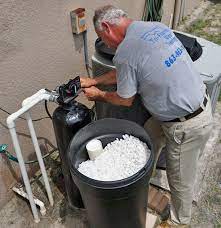Soft Water Systems: What You Need to Know
Drinking water is often something we take for granted. Especially when living in a first world country like the United States with high quality sanitation systems, we assume that all water must be good for you. However, this simply isn’t the case. Depending where you live, the local water will naturally pick up minerals like calcium that leads it to be considered “hard water”. It’s typically not something you want your tap water to be so it’s only natural to consider a filtration system. If you’re in this boat, then here is everything you need to know about soft water systems.
What is a soft water system?
A soft water system is one that reduces the hardness of tap water usually through ion exchange. A water softener system works by removing impurities and minerals from hard water using a filtration process. A typical set-up is often small enough to be placed inside and at home and can be connected to the water source installed in the home for a continuous water filtration process.
How does it work?
Ion exchange happens as hard water enters the water softening system, where the calcium and magnesium ions in the tap water are replaced with sodium ions. This process makes the water soft and available to use anywhere in the home. In most systems, resin beads are used as the bed for ion exchange. These resin beads need to be cleaned using a salt solution to remove the accumulated minerals to ensure the optimum performance of the soft water system.
What is hard water?
Hard water is water that contains high levels of minerals, most commonly calcium, magnesium, iron, and manganese. These deposits are present in water because in many places, water is sourced from natural reservoirs, and water coming from these places has to pass through deposits of limestone, gypsum, and chalk.
Hard water is present in household, commercial, and industrial settings. You may have hard water at home if your water does not produce bubbles or foam when agitated with soap, or when you see limescale and other mineral buildup on water heaters, kettles, and pipes and tubings.
Is hard water bad for you?
While minerals provide moderate health benefits if they are present in small amounts, high levels of these minerals can be considered a nuisance. Hard water can lead to deposits of minerals on appliances and pipes that can damage household equipment. For example, regular exposure to hard water can lead to a buildup of limescale in water heaters and kettles. Hard water also leads to underperformance of detergents, soaps and shampoos. Washing your hair with hard water can lead to dry hair because the minerals create a film over hair strands and scalp, making it harder for moisturizers to penetrate.
And though the minerals in hard water are not dangerous to your health on their own, large amounts of minerals like calcium, can indicate that there are other chemicals present that may well be more harmful. Chlorine as a good example of this.
What are the components of a water softener?
The three main components of a water softener are the control valve, mineral tank and brine tank. These three components work together to remove mineral impurities from hard water. The entire system is also self-cleaning which means this system can be set to periodically clean itself from minerals through a regeneration process.
Control valve
The control valve controls how much water passes through the mineral tank and into the house. It also tracks the resin beads' capacity to effectively filter hard water. Once the resin beads' filtration capacity has reached its maximum level, the control valve activates the regeneration cycle to restore the resin beads' ability to effectively soften the water.
Mineral tank
The mineral tank is where the actual softening process happens. It is where the resin beads are housed. The water passes through the resin beads and calcium and magnesium ions are replaced by sodium. The water then exits the mineral tank and into the main water supply of your home.
Brine tank
The brine tank contains the salt solution needed for regeneration. After several filtration cycles, the resin beads lose their capacity to effectively filter the minerals from hard water and they will need to be recharged. During regeneration, the salt solution flows out of its tank and into the mineral tank where it washes the resin and restores the resin beads' positive charge. Once recharged, the resin beads can now effectively filter the minerals in hard water once again.
Summary
If you live in an area where hard water is your only supply of water, you need to start using a soft water system today. Not only will it remove minerals and impurities from your drinking water, it can also improve the taste of your drinking water and lengthen the life of your household appliances and pipes.






